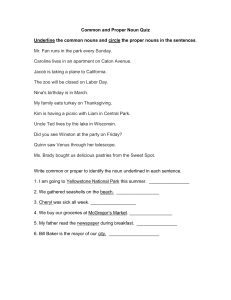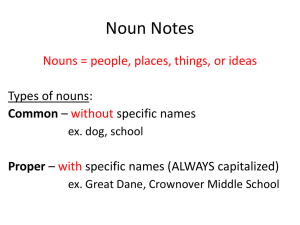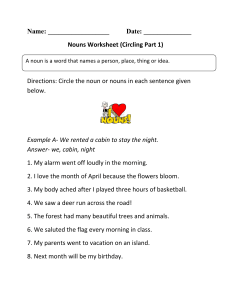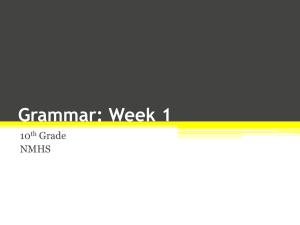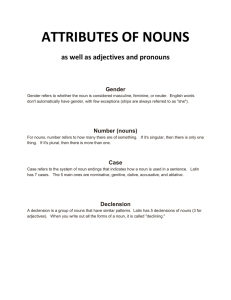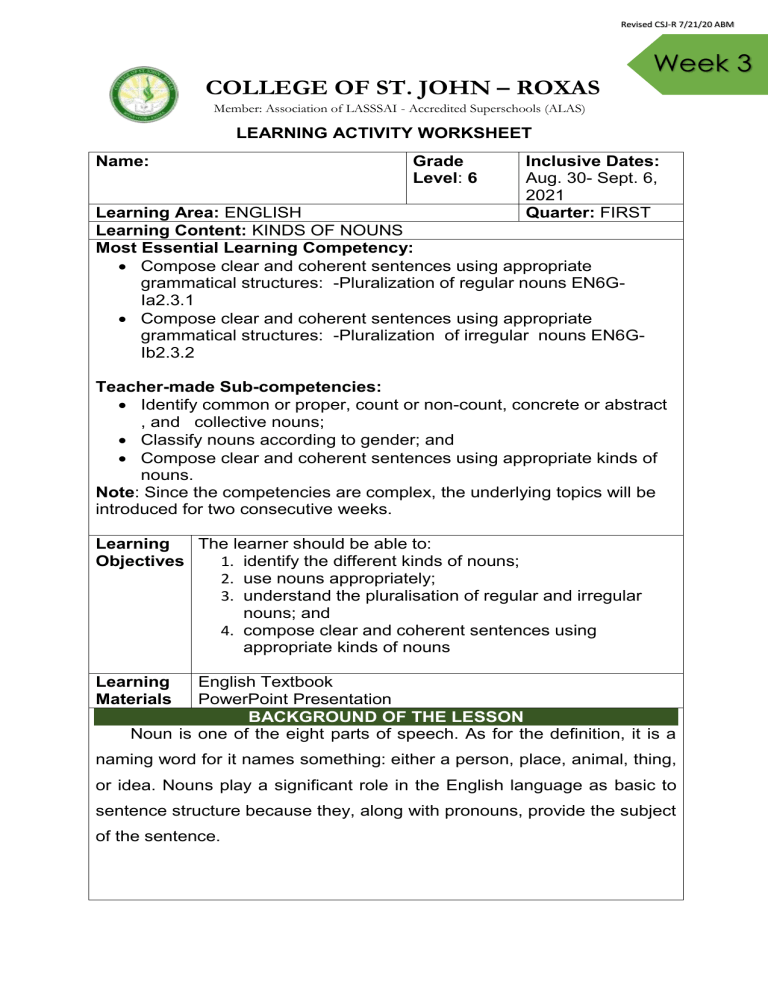
Revised CSJ-R 7/21/20 ABM COLLEGE OF ST. JOHN – ROXAS Week 3 Member: Association of LASSSAI - Accredited Superschools (ALAS) LEARNING ACTIVITY WORKSHEET Name: Grade Level: 6 Inclusive Dates: Aug. 30- Sept. 6, 2021 Quarter: FIRST Learning Area: ENGLISH Learning Content: KINDS OF NOUNS Most Essential Learning Competency: Compose clear and coherent sentences using appropriate grammatical structures: -Pluralization of regular nouns EN6GIa2.3.1 Compose clear and coherent sentences using appropriate grammatical structures: -Pluralization of irregular nouns EN6GIb2.3.2 Teacher-made Sub-competencies: Identify common or proper, count or non-count, concrete or abstract , and collective nouns; Classify nouns according to gender; and Compose clear and coherent sentences using appropriate kinds of nouns. Note: Since the competencies are complex, the underlying topics will be introduced for two consecutive weeks. Learning The learner should be able to: Objectives 1. identify the different kinds of nouns; 2. use nouns appropriately; 3. understand the pluralisation of regular and irregular nouns; and 4. compose clear and coherent sentences using appropriate kinds of nouns Learning Materials English Textbook PowerPoint Presentation BACKGROUND OF THE LESSON Noun is one of the eight parts of speech. As for the definition, it is a naming word for it names something: either a person, place, animal, thing, or idea. Nouns play a significant role in the English language as basic to sentence structure because they, along with pronouns, provide the subject of the sentence. ACTIVITY 1 It’s good to see you again. Pick up your learning kit. Let’s continue learning! Before we start, please say a prayer. Let’s get the ball rolling, kid! Directions: Study the following. What is noun? A noun is a name of person, place, thing, or idea. It is quite easy to determine which words name people or places. The words woman, teacher, and pupil refer to people. The words park, school, and Metro Manila refer to places. However, the classification thing is a different matter as it includes objects, animals, ideas, actions, conditions, and qualities. Study the following examples: Person Place Thing Idea Jordan, Kim, friend, neighbour school, terminal, house, subdivision envelope, shoes, umbrella, tricycle Fear, happiness, strategy, responsibility KINDS OF NOUNS • Regular/Irregular • Common/Proper • Count/Noncount • Concrete/Abstract • Collective • According to Gender (Masculine, Feminine, Common, Neuter) COMMON AND PROPER NOUNS Study common and proper nouns on page 13. You can also read the texts below for additional information. A common noun is a general name of a person, place, or thing. It does not begin with a capital letter. On the other hand, a proper noun names a specific person, place, or thing. It always begins with capital letter. COMMON park team basketball player sports tournament PROPER Rizal Park Philippine Azkals Paul Lee Palarong Pambansa ACTIVITY A. Directions: Read the poem below and look for nouns. Underline the common nouns and encircle the proper nouns. Clown is a Noun by Lill Pluta Clown is a noun. Car is a noun too. A clown in a car zips off to the zoo. He meets his friend, Sue. Sue is a gnu. Sue hops in the car with her buddy, Jack. Jack is so shaggy. Jack is a yak. Where they meet a crab, whose name is José. They shout, “Let's be friends!” José says, “Okay!” Five pals in a car drive back into town. Now it's your job to point out each noun. But first name the clown. Quick! Write it down! ACTIVITY 2 COUNT AND NONCOUNT NOUNS Study count and noncount nouns on page 13. You can also read the texts below for additional information. Nouns that refer to things which can be counted are called count nouns. They have singular and plural forms. On the other hand, nouns that refer to things which cannot be counted are called noncount nouns. Unlike count nouns, these nouns do not have plural forms. COUNT player ball bench pencil umbrella NONCOUNT energy blood salt air heat ACTIVITY Directions: For each noun in the list provided, encircle C for count and N for non-count. 1. pages C N 2. sand C N 3. towel C N 4. smoke C N 5. students C N ACTIVITY 3 CONCRETE, ABSTRACT, AND COLLECTIVE NOUNS Study concrete, abstract, and collective nouns on page 14. You can also read the texts below for additional information. A concrete noun names something that can be physically seen, touched, felt, smelled, tasted, or heard. On the other hand, an abstract noun names something that cannot be perceived by the senses. It is something nonphysical. CONCRETE ABSTRACT island wisdom laptop hope alcohol doubt perfume leadership spaghetti courage A collective noun names a group of people, places, or things. Examples of collective nouns are tribe, council, troupe, and team. Collective nouns can be either singular or plural depending on how they are used. To determine whether a collective noun is singular or plural, check how the unit acts. If the unit is acting as one, then it is singular. Example: The tribe decides on the laws to enact. (Here, the collective noun tribe acts as one in deciding which laws to enact.) If the individuals in the group are acting on their own, the collective noun should be considered as plural. Example: The tribe argue on the rules they want to suggest. (Here, the members of the noun tribe are acting individually as they are arguing with one another.) Activity A. Directions: Write the nouns in the box in their correct category. herd honor crowd support CONCRETE enthusiast building expertise skulk ABSTRACT frustration students COLLECTIVE ACTIVITY 4 Study the kinds of nouns according to gender (masculine, feminine, common, and neuter) on page 14. Then, answer the following activity. ACTIVITY A. Directions: Sort the nouns in the table according to their gender. Write them in the correct column. Asian duchess award actor MASCULINE Heroine Niece FEMININE teacher textbook COMMON laptop engineer NEUTER We end here today! Rest well and get ready for a new day tomorrow! Sayonara! :) REFERENCES Ramos-Espiel, M.G. (2016). Effective English for Lifelong Learning 6 Ramos-Espiel, M.G. (2020). English for Smart Learners 6 FOR THE STUDENT AND PARENT/GUARDIAN Date Accomplished: ________________ Date Submitted: ___________________ _____________________________________________________________ Signature of Student over Printed Name _____________________________________________________________ Signature of Parent/Guardian over Printed Name Prepared by: MISS MARIAN CRISTINE S. BORDO Teacher ONLINE CLASS INSTRUCTION SYNCHRONOUS REVIEW: Since the concept of noun is being taught in the previous grade levels, the students will answer on the Mentimeter to elicit their takeaways about noun. The teacher will discuss the different kinds of noun in real time using Google Meet. ASYNCHRONOUS As for assessment, the teacher will give exercises for each type of noun via Google docs.

